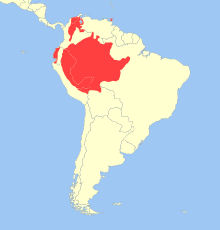| White-fronted capuchin | |
|---|---|

| |
| Scientific classification | |
| Domain: | Eukaryota |
| Kingdom: | Animalia |
| Phylum: | Chordata |
| Class: | Mammalia |
| Order: | Primates |
| Suborder: | Haplorhini |
| Infraorder: | Simiiformes |
| Family: | Cebidae |
| Subfamily: | Cebinae |
| Genus: | Cebus |
| Groups included | |

| |
| Geographic range of the various white-fronted capuchin species in South America | |
| Cladistically included but traditionally excluded taxa | |
White-fronted capuchin can refer to any of a number of species of gracile capuchin monkey which used to be considered as the single species Cebus albifrons. White-fronted capuchins are found in seven different countries in South America: Bolivia, Brazil, Colombia, Venezuela, Ecuador, Peru, and Trinidad and Tobago.
White-fronted capuchins are medium-sized monkeys with a light brown back and a creamy white underside. Like other capuchin monkeys, they are omnivorous, feeding primarily on fruits, invertebrates, other plant parts and sometimes small vertebrates. They are predated upon primarily by raptors and probably small cats, especially the margay, though snakes have been known to attack them. They are polygamous primates and live in fairly large groups of 15 to 35 individuals. Reproductive females give birth to a single young at biennial intervals. They maintain home ranges of 1.2 to 1.5 km2 (0.46 to 0.58 sq mi) and have complex vocal repertoires. They are among the few primates to have been observed crafting and utilising tools in the wild.
White-fronted capuchins are common and widespread, although their population may be declining.[1] The decline is believed to be caused by human-induced habitat loss and degradation, and hunting. In 2008 the International Union for Conservation of Nature (IUCN) classified the Ecuadorian white-fronted capuchin (C. equatorialis) and the Trinidad white-fronted capuchin (formerly regarded as C. albifrons trinitatis) as "critically endangered," and the varied white-fronted capuchin (Cebus versicolor) in Colombia as "endangered." The total population of the Trinidad subspecies was 61 at the last census.[citation needed]